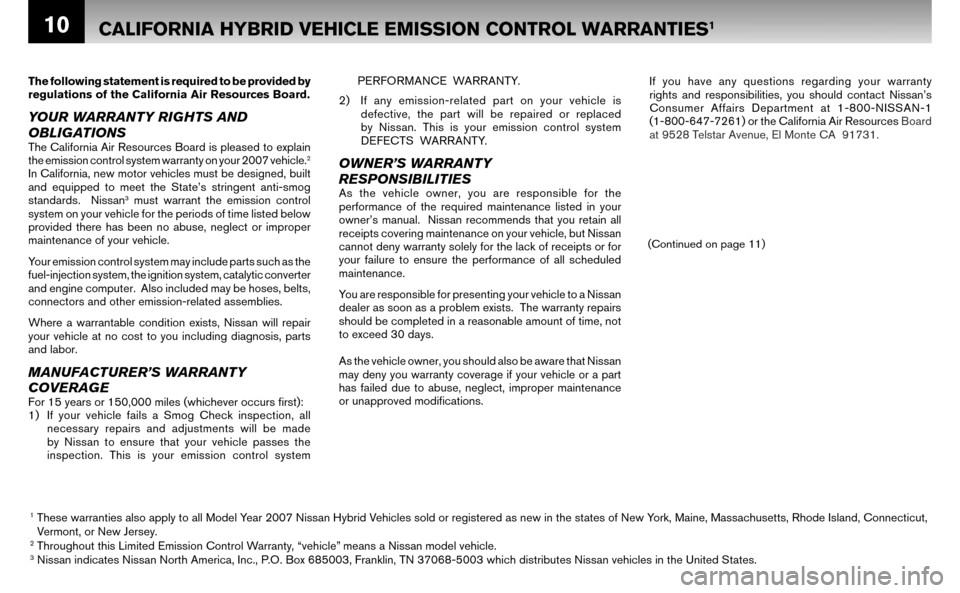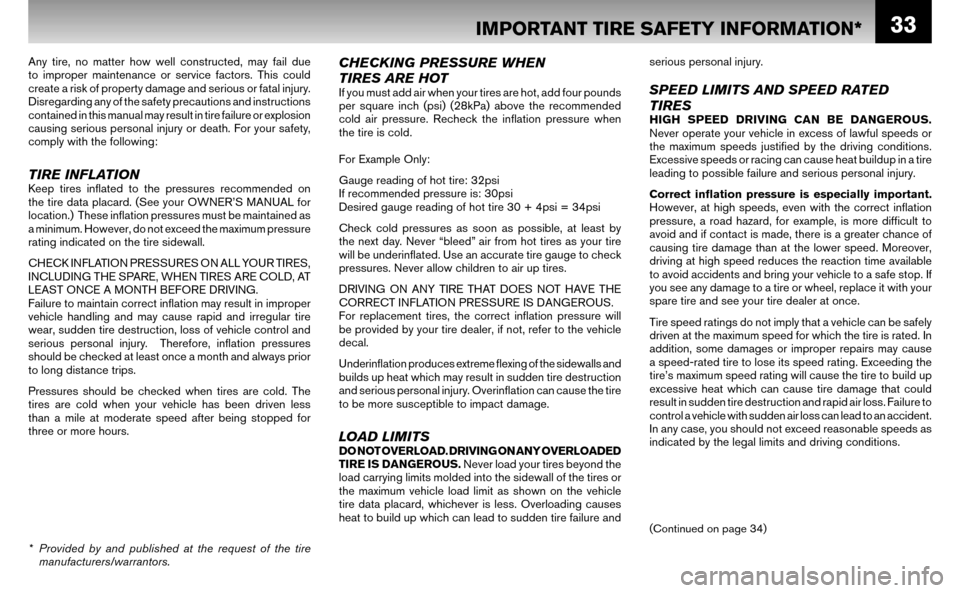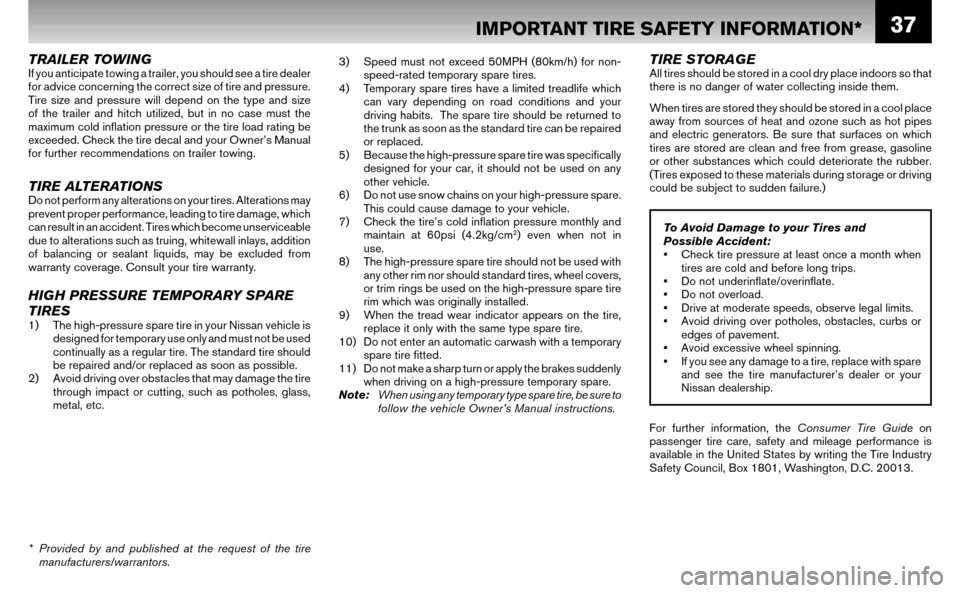2007 NISSAN ALTIMA HYBRID ECO mode
[x] Cancel search: ECO modePage 14 of 54

10
Ts
f
n
s
VThe following statement is required to be provided by
regulations of the California Air Resources Board.
YOUR WARRANTY RIGHTS AND
OBLIGATIONS
The California Air Resources Board is pleased to explain
the emission control system warranty on your 2007 vehicle.2
In California, new motor vehicles must be designed, built
and equipped to meet the State’s stringent anti-smog
standards. Nissan
3 must warrant the emission control
system on your vehicle for the periods of time listed below
provided there has been no abuse, neglect or improper
maintenance of your vehicle.
Your emission control system may include parts such as the
fuel-injection system, the ignition system, catalytic converter
and engine computer. Also included may be hoses, belts,
connectors and other emission-related assemblies.
Where a warrantable condition exists, Nissan will repair
your vehicle at no cost to you including diagnosis, parts
and labor.
MANUFACTURER’S WARRANTY
COVERAGE
For 15 years or 150,000 miles (whichever occurs fi rst):
1) If your vehicle fails a Smog Check inspection, all necessary repairs and adjustments will be made
by Nissan to ensure that your vehicle passes the
inspection. This is your emission control system
CALIFORNIA HYBRID VEHICLE EMISSION CONTROL WARRANTIES1
1 These warranties also apply to all Model Year 2007 Nissan Hybrid Vehicles sold or registered as new in the states of New York, Maine, Massachusetts, Rhode Island, Connecticut,
Vermont, or New Jersey.
2 Throughout this Limited Emission Control Warranty, “vehicle” means a Nissan model vehicle.3 Nissan indicates Nissan North America, Inc., P.O. Box 685003, Franklin, TN 37068-5003 which distributes Nissan vehicles in the United States.
(Continued on page 11)
If you have any questions regarding your warranty
rights and responsibilities, you should contact Nissan’s
Consumer Affairs Department at 1-800-NISSAN-1
(1-800-647-7261) or the California Air Resources Board
at 9528 Telstar Avenue, El Monte CA 91731.
PERFORMANCE WARRANTY.
2) If any emission-related part on your vehicle is defective, the part will be repaired or replaced
by Nissan. This is your emission control system
DEFECTS WARRANTY.
OWNER’S WARRANTY
RESPONSIBILITIES
As the vehicle owner, you are responsible for the
performance of the required maintenance listed in your
owner’s manual. Nissan recommends that you retain all
receipts covering maintenance on your vehicle, but Nissan
cannot deny warranty solely for the lack of receipts or for
your failure to ensure the performance of all scheduled
maintenance.
You are responsible for presenting your vehicle to a Nissan
dealer as soon as a problem exists. The warranty repairs
should be completed in a reasonable amount of time, not
to exceed 30 days.
As the vehicle owner, you should also be aware that Nissan
may deny you warranty coverage if your vehicle or a part
has failed due to abuse, neglect, improper maintenance
or unapproved modifi cations.
Page 37 of 54

33
Any tire, no matter how well constructed, may fail due
to improper maintenance or service factors. This could
create a risk of property damage and serious or fatal injury.
Disregarding any of the safety precautions and instructions
contained in this manual may result in tire failure or explosion
causing serious personal injury or death. For your safety,
comply with the following:
TIRE INFLATIONKeep tires infl ated to the pressures recommended on
the tire data placard. (See your OWNER’S MANUAL for
location.) These infl ation pressures must be maintained as
a minimum. However, do not exceed the maximum pressure
rating indicated on the tire sidewall.
CHECK INFLATION PRESSURES ON ALL YOUR TIRES,
INCLUDING THE SPARE, WHEN TIRES ARE COLD, AT
LEAST ONCE A MONTH BEFORE DRIVING.
Failure to maintain correct infl ation may result in improper
vehicle handling and may cause rapid and irregular tire
wear, sudden tire destruction, loss of vehicle control and
serious personal injury. Therefore, infl ation pressures
should be checked at least once a month and always prior
to long distance trips.
Pressures should be checked when tires are cold. The
tires are cold when your vehicle has been driven less
than a mile at moderate speed after being stopped for
three or more hours.
CHECKING PRESSURE WHEN
TIRES ARE HOT
If you must add air when your tires are hot, add four pounds
per square inch (psi) (28kPa) above the recommended
cold air pressure. Recheck the infl ation pressure when
the tire is cold.
For Example Only:
Gauge reading of hot tire: 32psi
If recommended pressure is: 30psi
Desired gauge reading of hot tire 30 + 4psi = 34psi
Check cold pressures as soon as possible, at least by
the next day. Never “bleed” air from hot tires as your tire
will be underinfl ated. Use an accurate tire gauge to check
pressures. Never allow children to air up tires.
DRIVING ON ANY TIRE THAT DOES NOT HAVE THE
CORRECT INFLATION PRESSURE IS DANGEROUS.
For replacement tires, the correct infl ation pressure will
be provided by your tire dealer, if not, refer to the vehicle
decal.
Underinfl ation produces extreme fl exing of the sidewalls and
builds up heat which may result in sudden tire destruction
and serious personal injury. Overinfl ation can cause the tire
to be more susceptible to impact damage.
LOAD LIMITSDO NOT OVERLOAD. DRIVING ON ANY OVERLOADED
TIRE IS DANGEROUS. Never load your tires beyond the
load carrying limits molded into the sidewall of the tires or
the maximum vehicle load limit as shown on the vehicle
tire data placard, whichever is less. Overloading causes
heat to build up which can lead to sudden tire failure and serious personal injury.
SPEED LIMITS AND SPEED RATED
TIRES
HIGH SPEED DRIVING CAN BE DANGEROUS.
Never operate your vehicle in excess of lawful speeds or
the maximum speeds justifi ed by the driving conditions.
Excessive speeds or racing can cause heat buildup in a tire
leading to possible failure and serious personal injury.
Correct infl
ation pressure is especially important.
However, at high speeds, even with the correct infl ation
pressure, a road hazard, for example, is more diffi cult to
avoid and if contact is made, there is a greater chance of
causing tire damage than at the lower speed. Moreover,
driving at high speed reduces the reaction time available
to avoid accidents and bring your vehicle to a safe stop. If
you see any damage to a tire or wheel, replace it with your
spare tire and see your tire dealer at once.
Tire speed ratings do not imply that a vehicle can be safely
driven at the maximum speed for which the tire is rated. In
addition, some damages or improper repairs may cause
a speed-rated tire to lose its speed rating. Exceeding the
tire’s maximum speed rating will cause the tire to build up
excessive heat which can cause tire damage that could
result in sudden tire destruction and rapid air loss. Failure to
control a vehicle with sudden air loss can lead to an accident.
In any case, you should not exceed reasonable speeds as
indicated by the legal limits and driving conditions.
* Provided by and published at the request of the tire manufacturers/warrantors.
IMPORTANT TIRE SAFETY INFORMATION*
(Continued on page 34)
Page 41 of 54

37
TRAILER TOWINGIf you anticipate towing a trailer, you should see a tire dealer
for advice concerning the correct size of tire and pressure.
Tire size and pressure will depend on the type and size
of the trailer and hitch utilized, but in no case must the
maximum cold infl ation pressure or the tire load rating be
exceeded. Check the tire decal and your Owner’s Manual
for further recommendations on trailer towing.
TIRE ALTERATIONSDo not perform any alterations on your tires. Alterations may
prevent proper performance, leading to tire damage, which
can result in an accident. Tires which become unserviceable
due to alterations such as truing, whitewall inlays, addition
of balancing or sealant liquids, may be excluded from
warranty coverage. Consult your tire warranty.
HIGH PRESSURE TEMPORARY SPARE
TIRES
1) The high-pressure spare tire in your Nissan vehicle is designed for temporary use only and must not be used
continually as a regular tire. The standard tire should
be repaired and/or replaced as soon as possible.
2) Avoid driving over obstacles that may damage the tire through impact or cutting, such as potholes, glass,
metal, etc. 3) Speed must not exceed 50MPH (80km/h) for non-
speed-rated temporary spare tires.
4) Temporary spare tires have a limited treadlife which can vary depending on road conditions and your
driving habits. The spare tire should be returned to
the trunk as soon as the standard tire can be repaired
or replaced.
5) Because the high-pressure spare tire was specifi cally designed for your car, it should not be used on any
other vehicle.
6) Do not use snow chains on your high-pressure spare.
This could cause damage to your vehicle.
7) Check the tire’s cold infl ation pressure monthly and maintain at 60psi (4.2kg/cm
2) even when not in
use.
8) The high-pressure spare tire should not be used with any other rim nor should standard tires, wheel covers,
or trim rings be used on the high-pressure spare tire
rim which was originally installed.
9) When the tread wear indicator appears on the tire, replace it only with the same type spare tire.
10) Do not enter an automatic carwash with a temporary spare tire fi tted.
11) Do not make a sharp turn or apply the brakes suddenly when driving on a high-pressure temporary spare.
Note: When using any temporary type spare tire, be sure to
follow the vehicle Owner’s Manual instructions.
TIRE STORAGEAll tires should be stored in a cool dry place indoors so that
there is no danger of water collecting inside them.
When tires are stored they should be stored in a cool place
away from sources of heat and ozone such as hot pipes
and electric generators. Be sure that surfaces on which
tires are stored are clean and free from grease, gasoline
or other substances which could deteriorate the rubber.
(Tires exposed to these materials during storage or driving
could be subject to sudden failure.)
To Avoid Damage to your Tires and
Possible Accident:
• Check tire pressure at least once a month when
tires are cold and before long trips.
• Do not underinfl ate/overinfl ate.
• Do not overload.
• Drive at moderate speeds, observe legal limits.
• Avoid driving over potholes, obstacles, curbs or
edges of pavement.
• Avoid excessive wheel spinning.
• If you see any damage to a tire, replace with spare
and see the tire manufacturer’s dealer or your
Nissan dealership.
For further information, the Consumer Tire Guide on
passenger tire care, safety and mileage performance is
available in the United States by writing the Tire Industry
Safety Council, Box 1801, Washington, D.C. 20013.
* Provided by and published at the request of the tire manufacturers/warrantors.
IMPORTANT TIRE SAFETY INFORMATION*